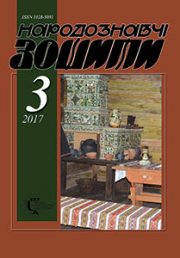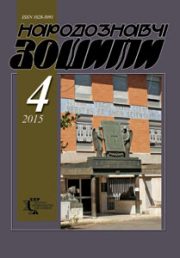The Ethnology Notebooks. 2021. # 2 (158), P. 287—302
УДК [398.33’34’43 + 393.1] (477 = 161.2)
DOI https://doi.org/10.15407/nz2021.02.287
Roman SILETSKYI
- ORCID ID: https://orcid.org/0000-0002-1451-5908
- doctor of Sciences in History, professor,
- Department of Ethnology,
- Ivan Franko National University of Lviv,
- 1, Universytetska Street,
- 79000, Lviv, Ukraine
- e-mail: r.sileckyj@gmail.com
THE CONCEPT OF CHOOSING IN CONSTRUCTION RITES OF VOLHYNIANS
Introduction. An article is devoted to folk customs, beliefs, signs and divinations of Volynians (a local group of Ukrainians) which took place in the complex of traditional building rituals. The proposed publication analyzes the block of rituals, which precedes the construction of housing.
The purpose of research is to find out the ritual and customary aspect of the choice of time, place and building materials (mainly wood) by the inhabitants of ethnographic Volhynia for the construction of residential and other buildings in order to ensure the health and well-being of the owners.
The object of research is the traditional ritual tools with which the people of Volyn made this ritual choice: beliefs, omens, ritual prohibitions, divinations. The publication pays attention to local (Volyn) features and all-Ukrainian features of the considered phenomenon of folk culture.
The territorial boundaries of the research extend to the historical and ethnographic Volyn, which is inhabited by one of the local groups of the Ukrainian people — Volynians.
The chronological framework of the research is determined by the state of the source base and covers the second half of the XIX — beginning of the XXI century.
Research methods — the principle of historicism, a systematic approach to the study of phenomena and objects of traditional culture is used to perform the article. The scientific implementation of the study involves a number of scientific methods: field ethnographic research with surveys, interviews, direct observation; historical-comparative; typological; comprehensive and retrospective analysis; historical reconstruction.
The source base of the proposed article is mostly new field ethnographic materials recorded by the author during ethnographic expeditions in the late XX — early XXI centuries on the territory of ethnographic Volhynia, as well as information found in the ethnographic works of researchers of the second half of the XIX — early XXI centuries (J.T. Stetsky, S. Rokosovskaya, G. Bulashev, B. Sokalsky, V. Kravchenko, R. Radovich).
Keywords: ethnology, Ukrainians, Volyn, building rituals, signs, rituals prohibitions, divinations, beliefs.
REFERENCES
- Bayburin, A.K. (1983). Dwelling in rites and performances of Eastern Slavs. Leningrad: Science: Leningrad Branch [in Russian].
- Siletsky, R. (2011). Traditional construction ritual of Ukrainians: monograph. Lviv: Ivan Franko National University of Lviv [in Ukrainian].
- Siletsky, R. (2013). Folk construction customs and rituals of residents of southern Volyn (according to the materials of Kremenets district of Ternopil region). In Bulletin of Lviv University. The series is historic (Issue 48, pp. 319—342). Lviv [in Ukrainian].
- Matviyas, I.G. (1999). Ukrainian language and its dialects. Kyiv: Naukova Dumka [in Ukrainian].
- Bulashev, G. (1992). Ukrainian people in their legends, religious views and beliefs. Cosmogonal Ukrainian folk views and beliefs (Pp. 316—318). Kyiv: Dovira [in Ukrainian].
- Archive of LNU. I. Franko. F. R-119. Op. 17. P. 522-E [in Ukrainian].
- Archive of LNU. I. Franko. F. R-119. Op. 17. P. 525-E [in Ukrainian].
- Archive of LNU. I. Franko. F. R-119. Op. 17. P. 523-E [in Ukrainian].
- Archive of LNU. I. Franko. F. R-119. Op. 17. P. 204-E [in Ukrainian].
- Archive of LNU. I. Franko. F. R-119. Op. 17. P. 524-E [in Ukrainian].
- Archive of LNU. I. Franko. F. R-119. Op. 17. P. 304-E [in Ukrainian].
- Archive of LNU. I. Franko. F. R-119. Op. 17. P. 526-E [in Ukrainian].
- Rokossowska, Z. (1889). About the plant world of the imagination, beliefs and administration of the Ruthenian people in The Wolynian village of Jurkowszczynie Zwiahel region. In Collection of messages to national anthropology (Vol. XIII, pp. 163—199). Krakow [in Polish].
- Sokalski, B. (1899). Sokalski District under geographical, ethnographic, historical and economic considerations. Lviv [in Polish].
- Archive of LNU. I. Franko. F. R-119. Op. 17. P. 206-E [in Ukrainian].
- Kravchenko, V. (1927). Fire. The matter is collected on the Right Bank. In Original citizenship and its relic in Ukraine (Issue 3, pp. 147—181). Kyiv [in Ukrainian].
- Siletsky, R. (2013). Traditional ritual requirements for felling the forest in Ukrainians. In Scientific notebooks of the Historical Faculty of Lviv University (Issue 14, pp. 100—121). Lviv [in Ukrainian].
- Kravchenko, V. (1920). Customs in the village of Zabriddia and on some others away from this village the areas of Zhytomyr country in Volyn. Ethnographic materials. Zhytomyr [in Ukrainian].
- Stecki, T.J. (1864). Wolyn under statistical, historical and archaeological depth (Vol. I). Lviv [in Polish].
- Kravchenko, V. (1996). Ethnographic essay (about Volyn). In Drevlyany. Collection of articles and materials on the history and culture of the Polissia Region (Issue I, pp. 257—278). Lviv [in Ukrainian].
- Radovych, R. (2012). Housing on ethnographic Volyn in the late 19th — beginning of the 20th century (according to the materials of Rivne region). In Architectural heritage of Volyn.
- Collection of scientific works (Issue 3, pp. 89—104). Rivne [in Ukrainian].






